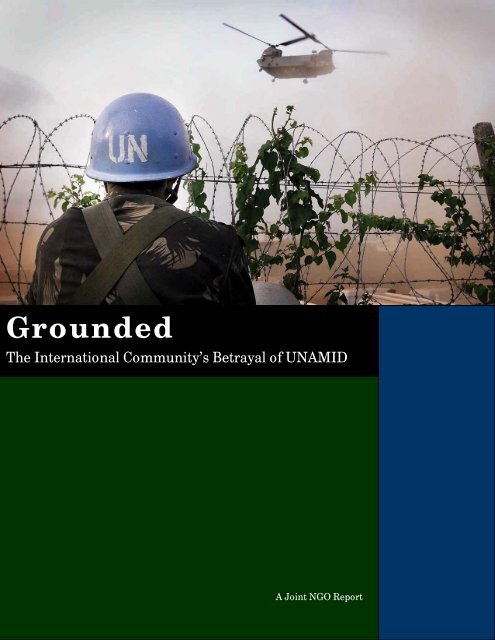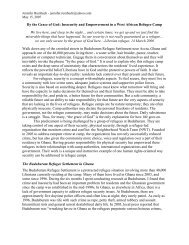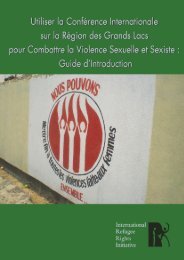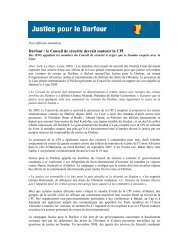The International Community's Betrayal of UNAMID
The International Community's Betrayal of UNAMID
The International Community's Betrayal of UNAMID
You also want an ePaper? Increase the reach of your titles
YUMPU automatically turns print PDFs into web optimized ePapers that Google loves.
Grounded<strong>The</strong> <strong>International</strong> Community’s <strong>Betrayal</strong> <strong>of</strong> <strong>UNAMID</strong>A Joint NGO Report
7.19 Spain ......................................................................................................... 227.20 Turkey ....................................................................................................... 227.21 Ukraine ...................................................................................................... 237.22 United Kingdom ........................................................................................... 237.23 United States <strong>of</strong> America............................................................................... 238.0 Conclusions ..................................................................................................... 249.0 Appendix: NATO medium lift helicopter capabilities................................................ 2610.0 Appendix: Summary <strong>of</strong> Available Helicopters by Country ...................................... 28NATO Countries without Suitable, Available Helicopters ............................................ 282
Organizations endorsing this reportAegis TrustAmericans Against Darfur Genocide<strong>The</strong> Arab Program for Human RightsActivists (APHRA)ARI Movement<strong>The</strong> Cairo Institute for Human RightsStudies<strong>The</strong> Centre for Army Conversion andDisarmament StudiesCollectif Urgence DarfourDarfur Action Group <strong>of</strong> South CarolinaDarfur Australia NetworkDarfur CallDarfur Hilfe e.V.Darfur Relief and Documentation CentreDarfur UnionENOUGH ProjectEuropean Union <strong>of</strong> Jewish StudentsFEMNETGenocide AlertGenocide Intervention Network<strong>The</strong> Human Rights Institute <strong>of</strong> SouthAfrica (HURISA)<strong>International</strong> Crisis Group<strong>International</strong> Refugee Rights InitiativeItalians for DarfurJapanese for DarfurNAS <strong>International</strong>Olympic Dream for DarfurPhysicians for Human RightsSan Francisco Bay Area Darfur CoalitionSave Darfur CoalitionSave Darfur CanadaSociety for Threatened PeoplesSudan Advocacy Action ForumSudan Organization Against Torture(SOAT)STAND CanadaTeam DarfurUnited Nations Association (UNA)Unitarian Universalist Service CommitteeWaging Peace3
ForewordA year ago today the United Nations Security Council voted unanimously to deploy UNpeacekeepers to protect the people <strong>of</strong> Darfur. This vote, which came after agreement forthe deployment had been struck with the Sudanese government, raised hopes that afterfour years <strong>of</strong> killings the international community would finally live up to its responsibility toprotect millions <strong>of</strong> Darfur residents driven from their homes by conflict. After years <strong>of</strong>passing empty resolutions while watching as about 300,000 Darfuris died according to UNestimates, villages were destroyed, and women and girls were raped, it appeared that atlast the outside world was moving from rhetoric to action.Following the visit that we made to Darfur in 2007, the Elders highlighted our concerns overinsufficient international financial, logistical and material support for deploying the UNmission. Almost one year later, our fears have regrettably been borne out. Rather thanstraining every sinew to make this mission work, the world community has failed to delivereven the basic support that the UN mission (<strong>UNAMID</strong>) needs to succeed. Today, <strong>UNAMID</strong>troops go unpaid, they are short on rations, and some are reduced to having to wear blueplastic bags on their heads because they do not even have the standard UN blue helmet.As a result, the people <strong>of</strong> Darfur remain as exposed as ever.One <strong>of</strong> the key gaps in the forces’ capability is the lack <strong>of</strong> helicopters. While no panacea,helicopters are essential for <strong>UNAMID</strong> to be able to operate effectively and react quickly in aregion the size <strong>of</strong> France. <strong>The</strong> force is seeking a mere 18 transport helicopters, whichcompares to around 350 on mission in Iraq. But so far, no country has stepped forward toprovide a single helicopter.This report sets out for the first time which states have the necessary helicopters andestimates how many are available for deployment to Darfur. It identifies a number <strong>of</strong>countries -- including the Czech Republic, India, Italy, Romania, Spain and Ukraine -- thathave large numbers <strong>of</strong> helicopters that meet the required specifications and are not onmission or mission rotation elsewhere. Many <strong>of</strong> these helicopters are gathering dust inhangars or flying in air shows when they could be saving lives in Darfur.<strong>The</strong> provision <strong>of</strong> these helicopters and other essential equipment would put added pressureon rebel groups and particularly the Government <strong>of</strong> Sudan to cease their resistance to4
<strong>UNAMID</strong> deployment; no longer would they be able to claim that the delay in <strong>UNAMID</strong>’sdeployment was the fault <strong>of</strong> the international community.<strong>The</strong> <strong>UNAMID</strong> operation is just one key to the securing lasting peace in Darfur. In addition,there must be broad-based negotiations among the belligerents and civil society actors tonegotiate a ceasefire and then permanent peace. Further, the 2005 Comprehensive PeaceAgreement, which ended decades <strong>of</strong> civil war between North and South in Sudan, must befully implemented to provide the broader national context for democratic governance andequitable distribution <strong>of</strong> wealth through the country.<strong>The</strong> time for action is now; the time <strong>of</strong> excuses and explanations is long past. We call onthe leaders in the countries cited above and others to exercise the leadership and mobilizethe political will to immediately make helicopters and other equipment available to the UNmission to save lives in Darfur. Our common humanity demands nothing less.Archbishop Desmond TutuLakhdar BrahimiPresident Jimmy CarterGraca MachelMembers <strong>of</strong> <strong>The</strong> Elders5
Executive Summary<strong>The</strong> United Nations Security Council voted one year ago to deploy a joint U.N.-African Unionpeacekeeping force, known as <strong>UNAMID</strong>, to protect the people <strong>of</strong> Darfur. But the world hasfailed to deliver the basic support that the mission needs to succeed. One <strong>of</strong> the key gaps inthe force’s capability is its lack <strong>of</strong> helicopters. Without helicopters, the force’s ability torespond quickly to events and fulfil its mandate to protect civilians is severely compromised.<strong>The</strong> July 8, 2008 attack on a <strong>UNAMID</strong> convoy in north Darfur underscores the criticalimportance <strong>of</strong> helicopters to the mission. <strong>The</strong> orchestrated attack left seven peacekeepersdead and 19 wounded after nearly three hours <strong>of</strong> ambush by armed militias. Withouthelicopters, <strong>UNAMID</strong> was unable to mount a rescue or reinforcement operation for thebeleaguered convoy. <strong>The</strong> consequences were deadly.This report, compiled by an aviation expert and endorsed by 36 human rights groups andnon-governmental organisations around the world, sets out for the first time data on whichcountries have suitable helicopters and how many are available for deployment to Darfur.While acknowledging the difficult political and logistical challenges, the report identifiesspecific countries that have suitable helicopters, sets out how many <strong>of</strong> these are known tobe committed to other missions, how many are required for national use, and how many arebeing serviced at any one time. Using this data, the report analyzes which countries arebest placed to provide the requisite helicopters to <strong>UNAMID</strong>.Using conservative estimates, the report calculates that NATO alone could provide as manyas 104 suitable helicopters for the <strong>UNAMID</strong> force. Among NATO countries, those countriesbest placed to provide helicopters to <strong>UNAMID</strong> are the Czech Republic, Italy, Romania andSpain. In addition, Ukraine and India – both countries that traditionally contribute to U.N.peacekeeping missions - could together contribute 34 helicopters. Between them, these sixcountries could provide an estimated fleet <strong>of</strong> over 70 helicopters - four times the numberrequired by <strong>UNAMID</strong>. Countries with the ability to provide these helicopters must do soimmediately, and Security Council members – especially the five permanent members -must engage in concerted diplomacy to make sure this happens.<strong>The</strong> aircraft surveyed for this report have the U.N.’s stipulated range and lift requirements.While it is possible that some aircraft may need modifications to their subsystems in order6
to comply fully with the U.N. requirements for the Darfur theatre, these costs should be metby the countries themselves, by the U.N., or through bi-lateral support from capablenations.Helicopters are not a panacea for the <strong>UNAMID</strong> force. <strong>The</strong> force also needs other equipment,including transport trucks, aerial reconnaissance capabilities, additional engineers and amulti-role logistics unit. Critically, the force needs to streamline the movement <strong>of</strong> equipmentand materials from Port Sudan to Darfur; otherwise, even the contribution <strong>of</strong> equipment willdo little to help the people <strong>of</strong> Darfur.Of course, <strong>UNAMID</strong> is not the ultimate solution to the crisis in Darfur, a ceasefire and realpeace talks are essential in order to bring a sustainable end to the fighting. But <strong>UNAMID</strong> is akey building block in helping to stabilise the situation and move to a context where anauthentic peace process is viable. If <strong>UNAMID</strong> is allowed to fail, it will affect all <strong>of</strong> theinternational community’s efforts and set back any prospect <strong>of</strong> peace for many years tocome. Helicopters must be contributed now to make the force truly operational and to senda clear signal that the international community is committed to <strong>UNAMID</strong> and the people <strong>of</strong>Darfur.7
Author BiographyThomas Withington is a defence analyst and writer based in France. He specialises inexamining military aviation and air power issues. He is an Associate Member <strong>of</strong> the RoyalAeronautical Society (RAeS), a member <strong>of</strong> the RAeS Air Power Working Group and aResearch Associate at the Centre for Defence Studies, King’s College, London. He hascompleted numerous research projects for a range <strong>of</strong> private and public sector clients oncontemporary and historic military aviation issues and is the author <strong>of</strong> four books.8
<strong>The</strong> U.N. expects helicopters performingCASEVAC/MEDEVAC to have the followingcapabilities:• 24/7 reaction time.• Alert-to-take-<strong>of</strong>f time <strong>of</strong> 30minutes.• Lift capability for four stretchers.• Ability to fly in day/nightInstrument Flight Rules (IFR)conditions.• Minimum range <strong>of</strong> 550 km (300nm).• Ability to utilise FARP.• Minimum 40-m (131-ft) lengthwinch cable capable <strong>of</strong> extractingtwo persons.For aircraft performing RECCE missions,the U.N. stipulates that these helicoptersmust have:• 24/7 response time.• FLIR.• Daylight video camera andrecording equipment.• Searchlight with up to 30-millioncandela <strong>of</strong> power.• Public Address (PA) system.• Ability to forward-deployed for upto three days.• A trained surveillance crew.<strong>The</strong> U.N.’s specifications for aircraft toperform SAR are similar to thosestipulated for the CASEVAC/MEDEVACaircraft, however these aircraft must havethe following capabilities:• PA system• FLIR• Searchlight with up to 30-millioncandela <strong>of</strong> power.• ELT compatibility with anAutomatic Direction Finder.Despite the very real need for thesehelicopters and months <strong>of</strong> appeals forthem by U.N. Department <strong>of</strong> PeacekeepingOperations, so far none have beenprovided.This paper sets out some <strong>of</strong> the countriesthat have helicopters fittings the U.N.’sspecifications. It goes on to set out howmany <strong>of</strong> these are known to be onmission, how many are required fornational use and how many are beingupgraded. From this data it sets out whichcountries are best placed to provide therequisite helicopters to <strong>UNAMID</strong>.10
2.0 NATO and leading U.N. aircraftcontributing nations’ combined medium lifthelicopter strength<strong>The</strong>re are many countries with availablecapacity at the right specification. Thisreport looks exclusively at the capacities<strong>of</strong> NATO countries and leading nationalcontributors <strong>of</strong> helicopters to support U.N.operations.On paper, the members <strong>of</strong> NATO and theleading U.N. aircraft contributorspotentially have over 3,700 helicopters 1which are publically reported to have atleast some <strong>of</strong> these specifications in terms<strong>of</strong> range and payload (see Appendix). It isalso reasonable to assume that theaircraft have some, if not all, <strong>of</strong> theequipment specifications stipulated abovesuch as FLIR, winches, machinegunmountings, searchlights, VHF/HF radios,EMT and PA systems.3.0 Existing NATO member states and leadingU.N. aircraft contributing nations’commitmentsHowever, not all <strong>of</strong> these 3,700 aircraftare available to support U.N.peacekeeping operations in Darfur.Several NATO members already haverotary wing aircraft committed to ongoingmilitary, peacekeeping and overseasobligations around the world. Forexample, France has helicopters deployedto support the EUFOR Chad/RCA(European Union Force Chad/CentralAfrican Republic) mission and aircraftsupporting NATO <strong>International</strong> SecurityAssistance Force (ISAF) operations inAfghanistan. Moreover, France also hasoverseas commitments in Djibouti, FrenchGuiana, French Polynesia, the French WestIndies and New Caledonia. 2This is also true <strong>of</strong> Germany, whichreportedly deploys helicopters in support<strong>of</strong> the ISAF mission along with aircraftwhich are supporting the Kosovo Force(KFOR) in the Balkans province,helicopters based in Djibouti and aircraftwhich are supporting the UNIFIL UnitedNations operation in Lebanon. 3Greece has at least two helicoptersdeployed domestically to provide anairborne ‘flying doctor’ mobile surgery11
service for the Greek population. 4 Italyshares UNIFIL commitments withGermany and Greece 5 and has alsodeployed helicopters in support <strong>of</strong> ISAFalong with the Netherlands, which has asignificant helicopter deployment inAfghanistan 6 . Norway also sendshelicopters to support UNIFIL and ISAF 7along with Poland, which supports thelatter and also has aircraft deployed tosupport military operations in Iraq. 8 Spainsupports UNIFIL operations in Lebanonwith helicopters 9 as does Turkey 10 , whichhas a commitment to deploy helicopters tonorthern Cyprus.Like France, the United Kingdom deploysseveral <strong>of</strong> its helicopters to overseaslocations including the Falkland Islandsand Brunei and the country supportsmilitary and peacekeeping operations inIraq and Afghanistan 11 . Finally, the UnitedStates has a major commitment <strong>of</strong> severalhundred helicopters to Afghanistan andIraq. 12Several NATO members also supplyhelicopters to ongoing peacekeepingoperations in the former Yugoslavia.However, NATO does not publicallyrelease figures on the quantities andnational origin <strong>of</strong> the helicopters deployedto support these commitments. 13 <strong>The</strong>same is also true for the European Councilwhich has overarching responsibility forEuropean Union Force deployments toBosnia-Herzegovina, Chad/Central AfricanRepublic and the Democratic Republic <strong>of</strong>Congo. 144.0 Technical issuesIn order to sustain a continual deployment<strong>of</strong> helicopters abroad, countries arerequired to maintain a number <strong>of</strong>helicopters at home. For example,according to the UK’s Secretary <strong>of</strong> Statefor Defence Des Browne, there is a basic‘rule <strong>of</strong> thumb’ that requires threehelicopters to support a single helicopterin theatre. 15 Essentially, while onehelicopter is operating in theatre, anotherwill be undergoing preparations to replacethe aircraft which has been deployed. Thismay include installing special equipmentsuch as sand filters if the aircraft isoperating in a desert environment,ballistic armour if there is a danger <strong>of</strong>small-arms fire being directed at theaircraft in the theatre <strong>of</strong> operations, orspecialist self-defence equipment todefend the aircraft against Surface-to-AirMissiles (SAMs).12
Meanwhile, a third aircraft may beundergoing Maintenance, Repair andOverhaul (MRO) at home following itsdeployment during which the helicoptermay have sustained damage or mayrequire complex servicing or replacement<strong>of</strong> essential systems such as the engines,power train, gearbox and rotor blades.Once these items are replaced or serviced,the aircraft will need to perform someflight testing to ensure that it is fullyairworthy and ready for deployment.Thus, in reality, to maintain a rollingthree-month deployment <strong>of</strong> fourhelicopters to an operational theatre, acountry would have to set aside twelvehelicopters to support this mission. It isalso important to note that MRO andequipment installation commitmentsincrease the more demanding theoperational theatre’s terrain and climate,and the more hostile the environment.<strong>The</strong> challenges that so-called ‘hot andhigh’ environments with high ambienttemperatures and rugged terrain pose tohelicopters are well-documented in thenews media. Moreover, helicopters arealso highly vulnerable to contaminationfrom sand particles, which can causeextensive damage to rotor blades andwhich make operations in desertenvironments hazardous.In addition to overseas commitments,armed forces will also retain a certainnumber <strong>of</strong> aircraft to support othercommitments such as domestic aircrewtraining; military exercises at home andabroad; and aircrews to maintain theirflying pr<strong>of</strong>iciency. Furthermore, an airforce or an army will most probably havea proportion <strong>of</strong> their fleet undergoing MROor upgrade programmes at any one time.Helicopters are ‘high maintenance’ assetswith significant numbers <strong>of</strong> moving partsand complex propulsion, avionics andweapons systems. A helicopter’s rotor,engine and transmission all experiencehigh stress levels, along with its airframewhich can be subjected to high levels <strong>of</strong>vibration. Failures <strong>of</strong> any <strong>of</strong> these systemscan cause the catastrophic loss <strong>of</strong> theaircraft and there is a major safetyimperative to ensure that the aircraft is inan airworthy condition at all times. Thisrequires the aircraft to undergo regularinspection and maintenance cycles.According to one source it is reasonable tosay that at any one time, up to 30 percent<strong>of</strong> a nation’s helicopter fleet may beundergoing MRO or domestic training,pr<strong>of</strong>iciency and exercise commitments. 16<strong>The</strong>se factors radically affect how manyspare helicopters a country may be able toprovide for a continual rolling deploymentabroad. However, when taking thesefactors into account, an examination <strong>of</strong>13
publically available information on currentNATO member and leading U.N. aircraftcontributing nations’ helicopter strengthsand commitments suggests that thesecountries have significant spare capacitywhich it could make available to supportU.N. missions.5.0 Availability <strong>of</strong> suitable aircraftAlthough the paper strength <strong>of</strong> NATOmembers and the leading U.N. aircraftcontributing countries in terms <strong>of</strong> mediumand heavy lift utility helicopters isimpressive, there are questions regardingthe suitability <strong>of</strong> these aircraft for socalled‘out-<strong>of</strong>-area’ operations in placessuch as Darfur.NATO’s helicopter fleets include legacyaircraft from the days <strong>of</strong> the Cold Warwhen the helicopter’s task would primarilybe to perform intra-theatre lift in CentralEurope to reinforce and resupply groundtroop formations in peacetime, or in theevent <strong>of</strong> a conflict with the Warsaw Pact. 17That said, Boeing’s CH-47 Chinook twinrotor helicopter has a particularly robustconstruction and has emerged as a toughworkhorse in the hot weather andmountainous terrain <strong>of</strong> Afghanistan. It hasa Maximum Take Off Weight (MTOW) <strong>of</strong>10,941-kg (22,798-lb) or around 33troops, with a range <strong>of</strong> up to 741 km (400nm). 18 However within the countriessurveyed, only Greece, Italy, theNetherlands, Spain, the United Kingdomand the U.S. possess these aircraft.Newer medium utility helicopter designssuch as the AgustaWestland AW-101 andthe Eurocopter NH-90 have similarlyimpressive weight, accommodation andrange capabilities but have only enteredservice in small numbers. In the case <strong>of</strong>the AW-101, Denmark, Portugal and theUK have around 48 <strong>of</strong> the troop-carryingTactical Transport Helicopter (TTH)version between them. Meanwhile, withinthe alliance, Germany, Italy, Norway arethe only countries which have so farreceived their NH-90s, with the Belgian AirComponent, Aviation Légère de l’Armée deTerre (French Army Light Aviation),Hellenic Army, Exército Português(Portuguese Army), Ejército de Tierra andEjército del Aire (Spanish Army andSpanish Air Force) expected to receivetheir machines over the next five years.<strong>The</strong> rest <strong>of</strong> NATO’s medium helicopterinventory is made up <strong>of</strong> Cold War-eradesigns such as the Eurocopter AS-14
332/532 Puma family <strong>of</strong> rotary aircraft(see Appendix). <strong>The</strong> situation is a littleimproved by the former Warsaw Pactmembers who have joined NATO such asBulgaria, Romania and Poland along withIndia, Pakistan and Ukraine. <strong>The</strong>secountries are equipped with a significantnumber <strong>of</strong> Mil Mi-8 and Mi-17 medium-liftaircraft, which are known for their robustconstruction. However some <strong>of</strong> theseaircraft may require the installation <strong>of</strong>subsystems such as FLIR or SAM selfdefencesbefore they would be adequatefor peacekeeping tasks.This is also the case for medium lifthelicopters operated by the WesternEuropean members <strong>of</strong> the NATO alliancewhich might lack the necessarysubsystems to support U.N. peacekeepingoperations. Not all <strong>of</strong> the aircraft ownedby the countries surveyed might be fittedwith the self-defence systems to allowthem to operate with adequate protectionin a region which could host a significantnumber <strong>of</strong> SAM threats. 19 Sudan is onesuch country with a high degree <strong>of</strong> SAMsystems, in particular highly-mobile9K32M Strela-2 (NATO reporting name‘SA-7 Grail’) MANPADS (Man Portable AirDefence Systems) which can be operatedby a single individual and which have thecapability to disable or destroy ahelicopter. 20To make matters more complex, severalNATO members are in the process <strong>of</strong>helicopter fleet renewal initiatives. 21 Asdiscussed above with the NH-90, manyNATO members are preparing to retiretheir older aircraft to replace them withnewer helicopters such as the NH-90 andAW-101. <strong>The</strong> result is that the designswhich are being replaced are towards theend <strong>of</strong> their active lives and are thereforemore maintenance-intensive to keepflying.At the same time, NATO members arefaced with an awkward situation by which,due to manufacturing delays on the NH-90, these aircraft are entering servicearound two years later than originallyplanned. <strong>The</strong> result is that there will befurther delays until the aircraft can becertified as fully operational and ready foractive service.This report has taken a survey <strong>of</strong> themedium lift machines now available to theNATO membership and the leading U.N.aircraft contributing nations, whichconform to the range and payloadrequirements stipulated by the U.N. Whilethe countries surveyed have thousand <strong>of</strong>helicopters in its combined fleet, only aproportion <strong>of</strong> these machines will adhereto the needs <strong>of</strong> the U.N. for the Darfurmission.15
6.0 Political issues<strong>The</strong> problem <strong>of</strong> securing helicopters forU.N. operations may not simply berestricted to availability; it may alsoconcern national political commitments.<strong>The</strong> deployment <strong>of</strong> helicopters to supportpeacekeeping operations can carry acertain degree <strong>of</strong> political baggage.Countries may be perceived as actors in aconflict no matter how even-handed andimpartial the deployment is intended tobe.Furthermore, the loss <strong>of</strong> an aircraft tohostile action during a peacekeepingdeployment, particularly if it results infatalities <strong>of</strong> troops and aircrew, couldcause domestic public support for themission to seriously decline. 22Demands for helicopters from the leadingcontributing nations and NATO membersto support peacekeeping missions will alsohave to compete with demands from otherquarters for rotary lift. Ongoing militaryoperations in Afghanistan have asignificant appetite for helicopters toassist combat in this mountainous countrywith its harsh climate. Helicopters are thepreferred means <strong>of</strong> mobility given thatthey are harder to attack than vehicleconvoys while also being able to travel athigh speeds and can operate without arunway. In November 2007, NATOSecretary General Jaap de Hoop Schefferasked alliance members to increase thenumber <strong>of</strong> helicopters based inAfghanistan. 237.0 Current helicopter availabilityestimations by NATO members and leadingU.N. aircraft contributing nationsBelgium, Canada, Estonia, Iceland andLuxembourg all lack suitable helicopterswhich have a basic conformity in terms <strong>of</strong>payload, range and accommodation withthe U.N. requirements stipulated above.Meanwhile, Norway, Germany and theUnited Kingdom do not appear to havesurplus aircraft which could be donated toa U.N. peacekeeping operation.However, Bulgaria, the Czech Republic,Denmark, France, Greece, Hungary, India,Italy, Latvia, Lithuania, the Netherlands,Pakistan, Poland, Portugal, Romania,Slovakia, Slovenia, Spain, Turkey,16
Ukraine, and the U.S. have some surplusaircraft which could be made available.In order to produce estimations on thenumber <strong>of</strong> helicopters which a countrymight be able to deploy, it is important tocalculate the number <strong>of</strong> aircraft needed tosustain current operations, along with thenumber <strong>of</strong> aircraft required for domesticobligations such as training, crewpr<strong>of</strong>iciency, MRO rotations, and upgradeand retr<strong>of</strong>it programmes.7.1 Bulgaria<strong>The</strong> Bulgarian air force operates Mil Mi-17and Eurocopter AS-532AL aircraft, <strong>of</strong>which it has 18 and eight airframesrespectively. 24 Bulgaria is not reported tohave any <strong>of</strong> these aircraft deployedabroad supporting overseas commitments.Given that up to 30 percent <strong>of</strong> the fleetmay be involved in domestic duties(training/pr<strong>of</strong>iciency/exercise, MRO;upgrade and retr<strong>of</strong>it) this could mean thatthe country has around 18 aircraftavailable to support internationalpeacekeeping efforts. Based on theguideline that three helicopters arerequired to maintain a single machine in arolling deployment to an operationaltheatre, the Bulgarian air force might beable to provide around six aircraft tosupport U.N. peacekeeping operation.7.2 Czech RepublicWith a fleet <strong>of</strong> around three Mil Mi-8s andup to 37 Mi-17I/Ish, the Vzdušné sílyArmády České republiky (Czech Air Force)has an impressive inventory <strong>of</strong> medium lifthelicopters. 25 With around 12 <strong>of</strong> thesemachines estimated to be involved innational commitments at any one time,the Czech government might be able tomake up to 28 aircraft available tosupport peacekeeping operations, whichcould allow for a rolling deployment <strong>of</strong> upto nine aircraft.However, the Czech government isthought to be under significant pressureto deploy any surplus helicopters toAfghanistan to support ISAF operations. InMay 2008, the U.S. government wasreported to be leading an initiative t<strong>of</strong>inance the upgrade <strong>of</strong> several <strong>of</strong> thecountry’s Mil-17s to outfit them withNATO-compatible equipment such asnight-vision and self-defence systems,identification friend-or-foe transpondersand secure radio communications. 26 <strong>The</strong>U.N. might have to compete with NATO insecuring any Czech air force medium lifthelicopters to support the organisations’peacekeeping efforts.17
7.3 Denmark<strong>The</strong> Flyvevåbnet (Royal Danish Air Force)has a fleet <strong>of</strong> around eight AW-101aircraft which were delivered from 2007. 27<strong>The</strong>se are advanced medium lifthelicopters which could be ideally suitedto assist U.N. missions. <strong>The</strong> country isestimated to maintain at least two <strong>of</strong>these aircraft for national commitmentswhich means that around six aircraft couldbe available to support U.N. operationstheoretically allowing for a rollingdeployment <strong>of</strong> two AW-101s.7.4 FranceFrance has one <strong>of</strong> Europe’s largestmedium lift helicopter fleets. <strong>The</strong> countryhas just over 200 SA-330Ba, AS-332C/L1,AS-532UL and SA-365N aircraft spreadacross the Armée de l'Air (French AirForce), the French Army and the Aviationnavale (Naval Aviation). 28 At the sametime, the country has a significantquantity <strong>of</strong> international commitments;with around three aircraft permanentlystationed in Chad to support the Frenchmilitary presence in that country, this is inaddition to the ten aircraft which aresupporting the EUFOR Chad/CAR missionand the approximately 10 helicoptersbased in Djibouti.<strong>The</strong> French government also deployshelicopters to French Guiana, FrenchPolynesia and the French West Indies, inaddition to around five machines whichare based in New Caledonia. 29 To maintainthe rolling deployment <strong>of</strong> these aircraft,the French armed forces are thought torequire a total <strong>of</strong> over 130 helicopters tosupport around 40 deployed aircraft. Inaddition, the country is estimated to havearound 60 aircraft permanently employedin support <strong>of</strong> national commitments. <strong>The</strong>result is that the government may nothave much spare capacity to deployadditional aircraft and may only be able tomuster about 10 additional machines toallow for a rolling deployment <strong>of</strong> aroundthree aircraft.7.5 GermanyLike France, Germany operates animpressive number <strong>of</strong> helicopters acrossits Luftwaffe (Air Force) and Heeresflieger(Army Aviation) operating around 86 AS-532U2, NH-90 and CH-53G aircraft. 30 It isimportant to note that <strong>of</strong> the 80 CH-53Gmachines that the country possesses, onlyaround 20 <strong>of</strong> them are considered fit fordeployments to support militaryoperations. <strong>The</strong> country has severalinternational commitments. In addition tothe estimated 30 machines Germany hasdeployed for national commitments, theGerman armed forces reportedly deployaround six helicopters to support ISAFoperations in Afghanistan 31 ; around 17 tosupport <strong>of</strong> KFOR commitments in Kosovo;plus three machines which are deployed to18
Djibouti and around four which supportthe UNIFIL mission in Lebanon. <strong>The</strong>secommitments effectively rule out anypossibility that Germany could deployadditional helicopters to support additionalU.N. operations. However, an upgradeprogramme for the 60 CH-53G aircraft notconsidered fit for purpose for overseasmissions could give some extra capacityto support the Darfur peacekeepingmission, although this could be timeconsuming and the German Ministry <strong>of</strong>Defence might not have the availablefunding for such a project.7.6 GreeceGreece operates around 24 EurocopterAS-332C1 and Boeing CH-47Dhelicopters. 32 <strong>The</strong> country hasinternational commitment deployinghelicopters to support UNIFIL and fordomestic medical services. It is estimatedthat Greece may have up to three surplusmachines which could be deployed insupport <strong>of</strong> U.N. operations, which wouldallow for a single aircraft to bepermanently based on a rollingdeployment.7.7 HungaryLike Bulgaria, the Czech Republic andPoland, the Hungarian Air Force operatesaround 23 Mi-17 and Mi-8 aircraft. 33 <strong>The</strong>country is not reported to have anyinternational commitments for itshelicopters and estimates predict thatHungary may have up to 16 surplusmachines which could be deployed insupport <strong>of</strong> U.N. operations. This couldpermit around five helicopters to bepermanently based in support <strong>of</strong> such anoperation on a rolling deployment.7.8 India<strong>The</strong> Bharatiya Vayu Sena (Indian AirForce) uses around 130 Mi-8 and Mi-17helicopters and is one <strong>of</strong> the largestoperators <strong>of</strong> these types in the world. 34However, the country deploys around 30<strong>of</strong> these aircraft in support <strong>of</strong> existing U.N.operations globally. 35 <strong>The</strong>se deploymentsare estimated to require around 90supporting aircraft to maintain thecommitments. In addition, the Indian airforce is estimated to have around 40helicopters supporting domesticobligations. <strong>The</strong>oretically, this could meanthat the country has up to 63 aircraftwhich might be available to support U.N.operations in Darfur. This could allow thecountry to provide around 20 machines toassist this operation.7.9 Italy<strong>The</strong> Aeronautica Militare (Italian Air Force)operates around 39 CH-47C aircraft. 36Italy maintains international commitmentsdeploying around six helicopters tosupport the UNIFIL and ISAF missions,although it is thought that these19
deployments do not always use the largeCH-47 aircraft. If this is indeed the case, itcould allow Rome to deploy up to 39aircraft in support <strong>of</strong> U.N. peacekeepingoperations, which would allow around 13aircraft to be based on a rollingdeployment.7.10 Latvia<strong>The</strong> Latvijas Gaisa spēki (Latvian AirForce) has a small force <strong>of</strong> around four MilMi-8 aircraft. 37 At least one <strong>of</strong> thesemachines will be deployed at any one timesupporting domestic commitments andtherefore the country could probably onlyspare a single aircraft to support a rollinginternational helicopter deployment.7.11 LithuaniaLike Latvia, the Lithuanian air force has asmall fleet <strong>of</strong> Mi-8 aircraft, possiblynumbering around eight aircraft. 38 It isestimated that at least two <strong>of</strong> theseaircraft might be deployed supportingnational commitments at any one timewhich in turn might mean that up to sixhelicopters could be available to helpsupport international peacekeepingdeployments. This could permit a rollingdeployment <strong>of</strong> up to two aircraft. As withall <strong>of</strong> the Mil helicopters operatedthroughout NATO, there might be theneed to significantly upgrade thesehelicopters with new subsystems beforethey could be considered fit for U.N.operations.7.12 Netherlands<strong>The</strong> Netherlands operates a significantnumber <strong>of</strong> helicopters across theKoninklijke Luchtmacht (RoyalNetherlands Air Force) with a fleetcontaining around 28 CH-47D and AS-532U2 medium transport helicopters. 39<strong>The</strong> country also has significantinternational commitments deployingaround three CH-47s to support ISAFoperations in Afghanistan 40 . At any onetime, around eight aircraft will bedeployed to support nationalcommitments. This leaves a balance <strong>of</strong>around eleven helicopters which could beused to support a rolling deployment <strong>of</strong> upto four aircraft to support a U.N.peacekeeping operation.7.13 PakistanPakistan Army Aviation is a significantuser <strong>of</strong> Mi-8 and Mi-17 helicopters. 41 <strong>The</strong>force operates around 40 <strong>of</strong> these aircrafttypes. Of these helicopters, around six aredeployed to existing U.N. operations 42 ,with a further 11 aircraft estimated to beinvolved with domestic obligations.Potentially, this could mean that the armymight have around nine aircraft whichcould be made available to support theU.N. mission in Darfur, which could allow20
the country to maintain a rollingdeployment <strong>of</strong> around three airframes.7.14 Poland<strong>The</strong> Polish armed forces have one <strong>of</strong> thebiggest Mi-8 and Mi-17 fleets in NATOwith over 50 aircraft spread across the airforce, army and navy. 43 <strong>The</strong> Polishgovernment has committed around eight<strong>of</strong> these aircraft to support ISAFoperations in Afghanistan which couldrequire around 24 helicopters to beearmarked to support this deployment. 44When national commitments are takeninto account, which probably absorbaround 15-20 aircraft, this could leaveapproximately 10 Mi-17s or Mi-8s tosupport international peacekeepingoperations. <strong>The</strong>se 10 aircraft would allowthe Polish government to maintain arolling deployment <strong>of</strong> around threehelicopters.7.15 Portugal<strong>The</strong> Portuguese are one <strong>of</strong> Europe’snewest AW-101 operators and around 12<strong>of</strong> the aircraft serve with the country’sForça Aérea Portuguesa (Portuguese AirForce). 45 <strong>The</strong> country is not reported to bedeploying any <strong>of</strong> these aircraft forinternational commitments, although it isestimated that around four <strong>of</strong> thehelicopters may be supporting nationalobligations at any one time. That wouldpotentially leave the air force free todeploy up to eight aircraft to support U.N.peacekeeping efforts, allowing for adeployment <strong>of</strong> between two to threehelicopters.7.16 Romania<strong>The</strong> Forţele Aeriene Române (RomanianAir Force) operates a mix <strong>of</strong> Western andRussian-designed medium lift helicoptersin the form <strong>of</strong> Mi-8 and ICA-Brasov IAR-330L helicopters; the latter being a locallyproduced version <strong>of</strong> the Eurocopter SA-330 Puma. 46 A number <strong>of</strong> these aircraftare also operated by the Forţele NavaleRomâne (Romanian Navy) which gives thecountry a medium lift utility helicopterfleet <strong>of</strong> around 37 aircraft. Like Portugal, itis unknown whether the country deploysany <strong>of</strong> these aircraft in support <strong>of</strong>international obligations, althoughdomestic commitments could require thecountry to use around eleven machines.This potentially would make around 26aircraft available to support U.N.peacekeeping operations, which couldtranslate into the country being able tomaintain a permanent deployment <strong>of</strong> upto nine aircraft.7.17 SlovakiaWith a helicopter fleet size similar to theirBaltic counterparts, the Vzdušné silyozbrojených síl Slovenskej republiky(Slovak Air Force) has a modest-sizedmedium lift helicopter fleet comprising21
around 15 Mi-8 and Mi-17 aircraft. 47Following the end <strong>of</strong> Slovakia’s 2007–2008 operational deployment <strong>of</strong> Mi-17helicopters in Kosovo (NATO KFOR), it nolonger has any helicopters deployed insupport <strong>of</strong> international operations. <strong>The</strong>country is estimated to maintain up to fivemachines in support <strong>of</strong> domesticcommittments. <strong>The</strong> Slovakian air forcecould make around eleven machinesavailable to support U.N. operations,which would allow the country to performa rotating deployment <strong>of</strong> up to fouraircraft.7.18 Slovenia<strong>The</strong> Slovenska vojska (Slovenian AirForce) maintains a small force <strong>of</strong> aroundfour AS-532AL aircraft. <strong>The</strong> country is notthought to have any <strong>of</strong> these aircraftdeployed on international operations, andis estimated to have at least onehelicopter supporting nationalcommitments. This could allow the airforce to provide up to three aircraft toreinforce U.N. operations, which wouldallow the country to maintain a rollingcommitment <strong>of</strong> one aircraft.7.19 Spain<strong>The</strong> Spanish armed forces have acombined medium lift helicopter fleet <strong>of</strong>just over 50 aircraft spread across theEjército del Aire (Spanish Air Force) andthe Fuerzas Aeromóviles del Ejército deTierra (Spanish Army Airmobile Force). 48<strong>The</strong> country operates SA-300J/L, AS-332B/B1/UL, CH-47D and AS-532ULhelicopters and has at least two aircraftreportedly deployed with the U.N. insupport <strong>of</strong> the UNIFIL mission, requiringat least six helicopters to be available,plus a further two machines supportingISAF commitments requiring six aircraft tobe available. 49 In addition to this, thecountry is estimated to have around 14machines earmarked for nationalcommitments. This could mean thatMadrid has up to 18 aircraft to supportU.N. operations, which could allow thecountry to maintain a rolling commitment<strong>of</strong> around six aircraft.7.20 Turkey<strong>The</strong> Turkish armed forces have one <strong>of</strong>NATO’s largest helicopter fleets. <strong>The</strong>country has around 120 medium liftaircraft spread across the Türk HavaKuvvetleri (Turkish Air Force) and TürkKara Kuvvetleri (Turkish Army). 50 <strong>The</strong>country’s helicopter fleet includes AS-532UL and Sikorsky S-70A aircraft. <strong>The</strong>country maintains internationaldeployments to the UNIFIL operation inLebanon, reportedly deploying aroundthree aircraft. 51 It also has domesticcommitments which may absorb around30 machines, plus deployments <strong>of</strong> aircraftto Northern Cyprus. In addition, theTurkish armed forces also deploy22
machines to support the ISAF mission inAfghanistan and a significant proportion <strong>of</strong>aircraft are also being utilised for ongoing<strong>of</strong>fensive operations in Iraq. Because <strong>of</strong>these factors, it is estimated that theTurkish armed forces might be able tomake up to six machines available tosupport U.N. peacekeeping operations,which could allow for two aircraft to beutilised on a rolling deployment.7.21 UkraineBetween them, the Povitryani SylyUkrayiny (Ukrainian Air Force),Sukhoputni Viys’ka ZSU (Ukrainian Army)and the Viys’kovo-Mors’ki Syly Ukrayiny(Ukrainian Navy) operate around 116 MilMi-8 aircraft. 52 Of those aircraft, anestimated 35 helicopters are fulfillingdomestic commitments. In addition,Ukraine deploys around 13 aircraft toassist U.N. operations worldwide 53 , whichrequires an estimated supporting force <strong>of</strong>around forty aircraft. <strong>The</strong>refore, Ukrainemay have up to 42 surplus aircraft whichcould support U.N. operations in Darfur.This could allow for a rolling deployment<strong>of</strong> around 14 aircraft.7.22 United KingdomLike France, the UK has a particularlyheavy international commitment <strong>of</strong>medium lift helicopters. On paper, thestrength <strong>of</strong> the Royal Air Force fleet isplaced at around ninety aircraft whichincludes AW-101, Eurocopter Puma HC1and Boeing Chinook HC2 machines. 54However, many <strong>of</strong> these helicopters aredeployed to Afghanistan, Brunei, theFalkland Islands and Iraq which it isestimated requires around 80 aircraft tobe available. In addition, surplus aircraftmay be based at home for domesticcommitments. <strong>The</strong> UK medium lift fleet isparticularly taxed at present and there is arecognised need for extra helicopters tosupport operations in Afghanistan. 55Because <strong>of</strong> this demand, any sparecapacity will almost certainly go tosupport this existing UK commitment.7.23 United States <strong>of</strong> America<strong>The</strong> U.S. armed forces have NATO’s thebiggest medium lift helicopter fleet withover 2,100 Boeing CH-46E, CH-53D/E,Bell-Boeing CV-22, CH-47D and SikorskyUH-60A/L/M aircraft spread across the AirForce, Army and Marine Corps. 56 Thatsaid, the U.S. has by far the largestnumber <strong>of</strong> international commitments <strong>of</strong>any <strong>of</strong> the Alliance members. Up to 1,170aircraft may be required to support thecontinued deployment in Iraq, with over200 machines supporting the deploymentto Afghanistan. Furthermore, the countryis estimated to have over 640 aircraftmaintaining crew pr<strong>of</strong>iciency, training,MRO and upgrade and retr<strong>of</strong>itrequirements. This could allow the countryto earmark just over 100 aircraft to23
support U.N. operations, which wouldenable around 30 aircraft with rollingdeployment.However, the Department <strong>of</strong> Defense hasalready warned that it might not have theaircraft capacity to assist U.N. operationsin Darfur. When asked about sparehelicopters, Defense Secretary RobertGates said that the current fleet wasalready “pretty pushed” in terms <strong>of</strong>commitments to Iraq and Afghanistan. Infact, the depth <strong>of</strong> these commitments issuch that the U.S. is applying pressure toother NATO members to supplyhelicopters to support operations inAfghanistan where the need for suchaircraft is particularly acute.8.0 ConclusionsBased on the analysis above, NATO andthe leading U.N. aircraft contributingnations might have circa 140 aircraftwhich could be available to the U.N. forrolling deployments to peacekeepingoperations.This figure does not take into account all<strong>of</strong> the medium lift helicopters which aresupporting NATO commitments in theformer Yugoslavia and also EuropeanForce obligations. NATO members mayalso have international commitments fortheir medium lift aircraft which have notbeen publically reported and for which thefigures are unknown. However, despitethese limitations, the relatively smallnumber <strong>of</strong> helicopters involved in thesemissions means they will not significantlyaffect the conclusions <strong>of</strong> this report.Based on the analysis above, thosecountries best placed to providehelicopters to <strong>UNAMID</strong> are:1. India2. Ukraine3. Czech Republic4. Italy5. Romania6. SpainBetween them, these countries would beable to provide an estimated helicopterfleet <strong>of</strong> seventy helicopters. That is fourtimes the number required by <strong>UNAMID</strong>.<strong>The</strong> aircraft surveyed for this report havethe U.N.’s stipulated range and liftrequirements; it is possible that some <strong>of</strong>them may need modifications to theirsubsystems in order to comply fully withthe U.N. requirements for the Darfur24
theatre. <strong>The</strong>se costs – which can beconsiderable – could be met by thecountries themselves or by the U.N.<strong>The</strong> figures set out above are necessarilyestimates given the reluctance <strong>of</strong>governments to publicly make such dataavailable.25
9.0 Appendix: NATO medium lift helicoptercapabilitiesHelicopter Range Payload Accommodation OperatorcountriesAgustaWestlandAW-1011,389 km (750nm)15,500-kg(34,171-lb)MTOWUp to 45personnelDenmark,Portugal,UnitedKingdomBoeing CH-46E 383 km (206nm)11,000-kg(24,250-lb)MTOWUp to 25personnelUnited StatesBoeing CH-47C/D741 km (400nm)22,280-kg(49,118-lb)Up to 33personnelGreece, Italy,Netherlands,Spain, UnitedKingdomEurocopter SA-330Ba/J/L572 km (308nm)7,400-kg(16,314-lb)MTOWUp to 20personnelFrance,Spain, UnitedKingdomEurocopter AS-332B1/L1/C/C1830 km (448nm)8,600-kg(18,959-lb)Up to 20personnelFrance,Greece,Spain, UnitedKingdomEurocopter AS-532AL/UL/U21,215 km (656nm)9000-kg(19841-lb)MTOWUp to 21personnelBulgaria,France,Germany,Netherlands,Slovenia,Spain,Turkey,UnitedKingdomEurocopter NH-901,203 km (649nm)23,370-kg(51,522-lb)MTOWUp to 20personnelGermanyICA-BrasovIAR-330L572 km (308nm)7,400-kg(16,314-lb)MTOWUp to 17personnelRomaniaMil Mi-17/1Sh 950 km (512nm)13,000-kg(28,660-lb)MTOWUp to 32personnelBulgaria,CzechRepublic,Hungary,Poland,Slovakia26
Helicopter Range Payload Accommodation OperatorcountriesMil Mi-8/P/S/T/R/L460 km (248nm)11,000 kg(24,250-lb)MTOWUp to 24personnelCzechRepublic,Hungary,Latvia,Lithuania,Poland,Romania,SlovakiaSikorsky CH-53D/G/E1,000 km (539nm)Up to 19,100kg (42,108-lb)MTOWUp to 37personnelGermany,U.S.Sikorsky UH-60/S-70592 km (319nm)Up to 11,113kg (24,499-lb)Up to 14personnelTurkey, U.S..Sources: Endres, G, Gething, M, Jane’s Aircraft Recognition Guide, Jane’s Information,Group, Coulsdon, 2002; Donald, D, <strong>The</strong> Pocket Guide to Military Aircraft, Bounty Books,London 2001; http://www.airforce-technology.com/projects27
10.0 Appendix: Summary <strong>of</strong> AvailableHelicopters by CountryCountryEstimated AvailableHelicoptersCategoryBulgaria 6 NATOCzech Republic 9 NATODenmark 2 NATOFrance 3 NATOGreece 1 NATOHungary 5 NATOItaly 13 NATOLatvia 1 NATOLithuania 2 NATONetherlands 4 NATOPoland 3 NATOPortugal 3 NATORomania 9 NATOSlovakia 4 NATOSlovenia 1 NATOSpain 6 NATOTurkey 2 NATOUSA 30 NATOIndia 20Traditional UNContributorPakistan 3Traditional UNContributorUkraine 14Traditional UNContributorNATO Countries without Suitable, Available HelicoptersBelgiumCanadaEstoniaIcelandLuxembourgNorwayGermanyUnited Kingdom28
Notes1 2008 Aviation Source Book, Aviation Week and Space Technology, McGraw Hill, 20082 France: Jane’s Sentinel Security Assessments, Jane’s Information Group, Coulsdon 20083 Germany: Jane’s Sentinel Security Assessments, Jane’s Information Group, Coulsdon 20084 Tsiliopoulous, ‘Military copter shortage affects Greek readiness’ @http://www.sper<strong>of</strong>orum.com/site/article.asp?idarticle=149255 Italy: Jane’s Sentinel Security Assessments, Jane’s Information Group, Coulsdon 20086 Netherlands: Jane’s Sentinel Security Assessments, Jane’s Information Group, Coulsdon20087 Annual Review <strong>of</strong> Global Peace Operations 2008, Centre on <strong>International</strong>Cooperation/Lynne Reiner, Boulder, 20088 Glowacki, B, ‘Poland to send upgraded Mi-17 transport helicopters to Afghanistan’, Flight<strong>International</strong>, 25 th March 20089 Spain: Jane’s Sentinel Security Assessments, Jane’s Information Group, Coulsdon 200810 Turkey: Jane’s Sentinel Security Assessments, Jane’s Information Group, Coulsdon 200811 United Kingdom: Jane’s Sentinel Security Assessments, Jane’s Information Group,Coulsdon 200812 <strong>The</strong> Military Balance 2008, <strong>International</strong> Institute <strong>of</strong> Strategic Studies, Routledge, London,200813 Conversation with senior NATO media liaison <strong>of</strong>ficial, 25 th June 2008.29
14 Conversation with EU press representative, 26 th June 2008.15 Des Browne, Secretary <strong>of</strong> State, Ministry <strong>of</strong> Defence, Written Ministerial Statement,Hansard, 20 th May 2008.16 Conversation with senior NATO media liaison <strong>of</strong>ficial17 Marcus, J, ‘Helicopter shortage in overseas mission’ @www.bbc.co.uk/news 11 th January200818 Donald, D, <strong>The</strong> Pocket Guide to Military Aircraft, Bounty Books, London 2001 and ‘CH-47E/F/MH-47E Chinook Heavy Lift Helicopter’ @http://www.airforcetechnology.com/projects/chinook/specs.html19 ‘Getting boots <strong>of</strong>f the ground’, <strong>The</strong> Economist, 24 th January 200820 <strong>The</strong> Military Balance 200821 John, M, ‘Analysis – Helicopter crunch hobbles peace missions’, Reuters, 27 November200722 ibid23 ‘NATO About to Lease Troops Helis for Afghanistan?’, Defense Industry Daily, 8 thNovember 200724 2008 Aviation Source Book, Aviation Week and Space Technology, McGraw Hill, 200825 ibid26 Lok, JJ, ‘Mi-17 Upgrade Aims to Fill NATO Helo Gap’, Aviation Week and SpaceTechnology, 27 th May 200827 2008 Aviation Source Book28 ibid30
29 France: Jane’s Sentinel Security Assessments30 2008 Aviation Source Book31 Germany: Jane’s Sentinel Security Assessments32 2008 Aviation Source Book33 ibid34 ibid35 Annual Review <strong>of</strong> Global Peace Operations 200836 2008 Aviation Source Book37 ibid38 ibid39 ibid40 Netherlands: Jane’s Sentinel Security Assessments41 2008 Aviation Source Book42 Annual Review <strong>of</strong> Global Peace Operations 200843 2008 Aviation Source Book44 Glowacki, B, ‘Poland to send upgraded Mi-17 transport helicopters to Afghanistan’, Flight<strong>International</strong>, 25 th March 200845 2008 Aviation Source Book46 ibid31
47 ibid48 ibid49 Annual Review <strong>of</strong> Global Peace Operations 200850 2008 Aviation Source Book51 Turkey: Jane’s Sentinel Security Assessments and Annual Review <strong>of</strong> Global PeaceOperations 200852 2008 Aviation Source Book53 Annual Review <strong>of</strong> Global Peace Operations 200854 2008 Aviation Source Book55 Harrell, E, ‘Helicopter crisis hits battle with Taliban’, <strong>The</strong> Scotsman, 16 th June 200756 2008 Aviation Source Book32








